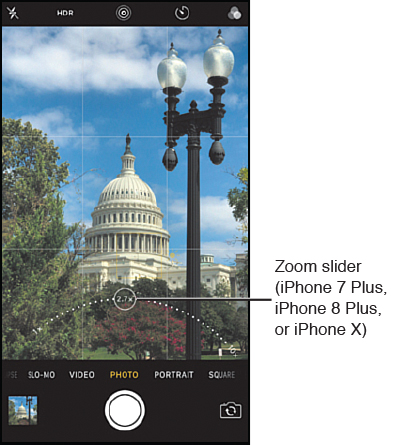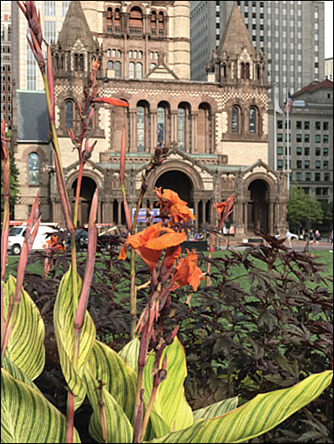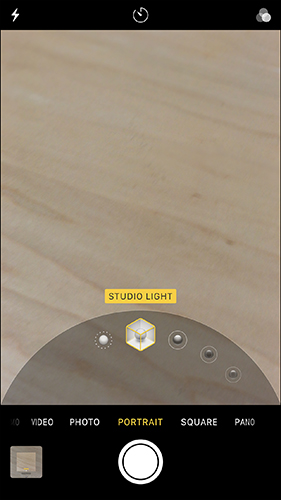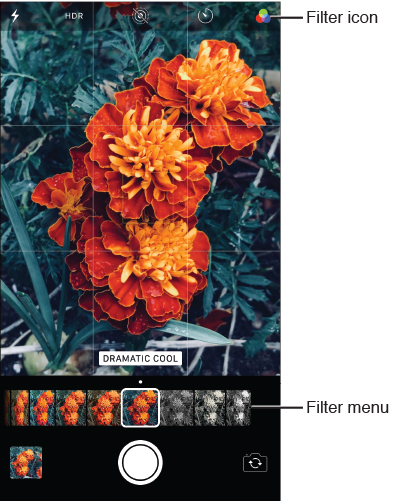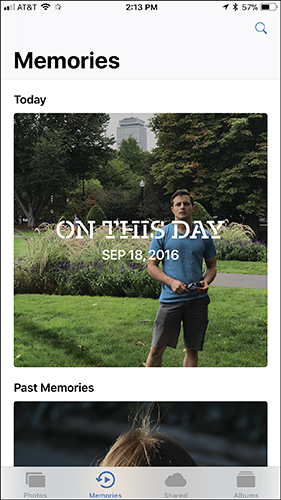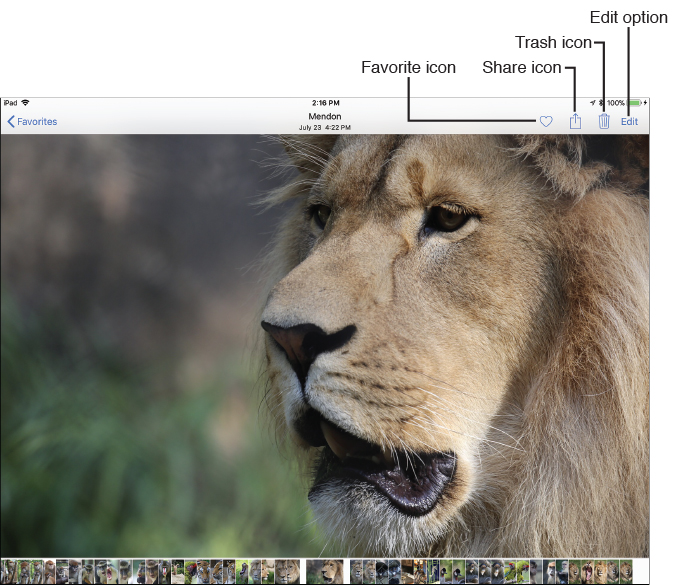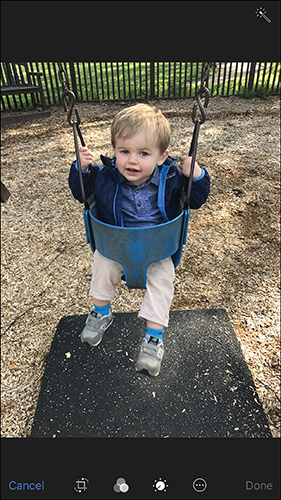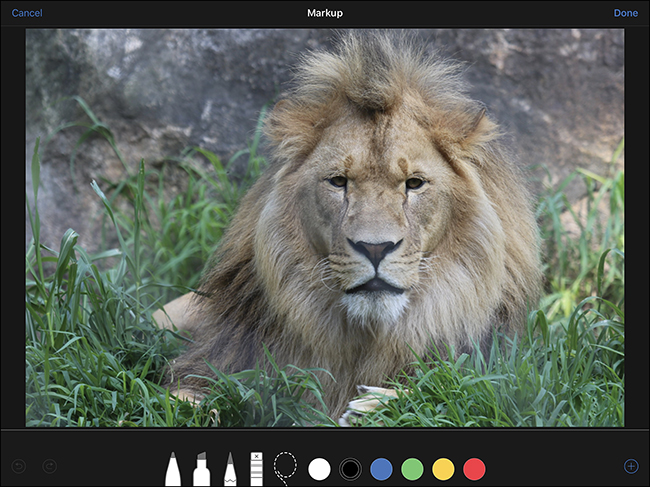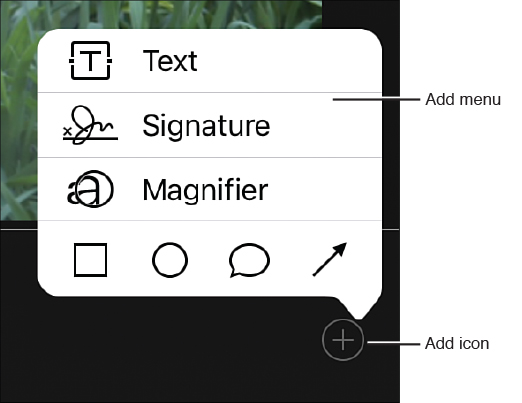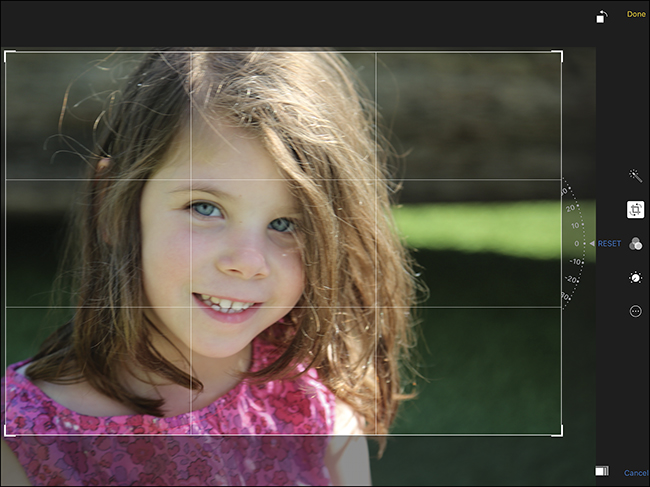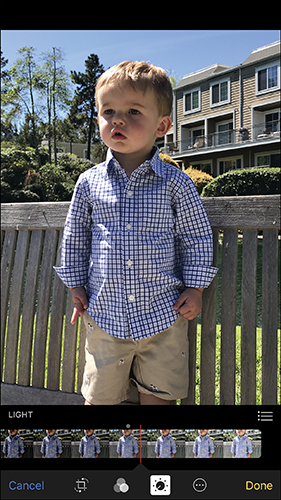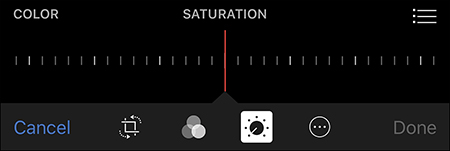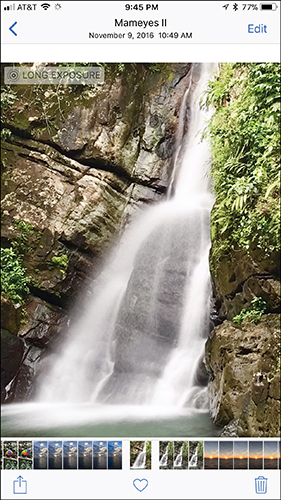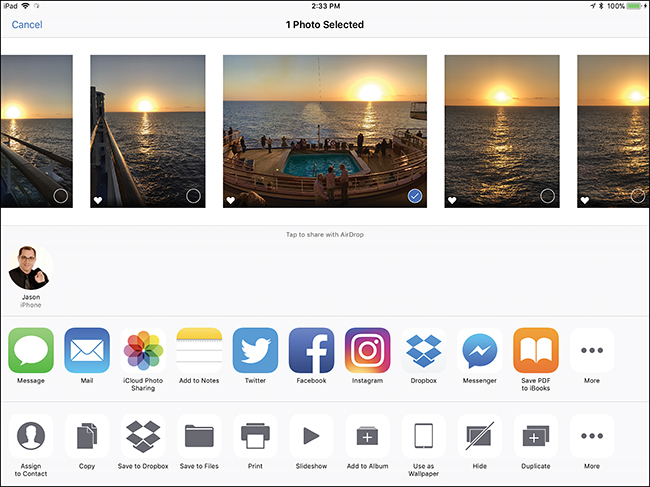9. Shoot, Edit, and Share Photos and Videos
In this Chapter
![]() Discovering the image-editing tools built in to the Photos app
Discovering the image-editing tools built in to the Photos app
![]() Learning about the Camera app’s Selfie and Live Picture features
Learning about the Camera app’s Selfie and Live Picture features
![]() Taking advantage of the improved Portrait mode with the new Portrait Lighting feature on the iPhone 8 Plus and iPhone X.
Taking advantage of the improved Portrait mode with the new Portrait Lighting feature on the iPhone 8 Plus and iPhone X.
Every day, more than 1.5 billion photos are taken on smartphones and tablets around the world. People love taking photos, and thanks to the digital cameras built in to all the iPhone and iPad models, plus improvements made to the iOS 11 edition of the Camera and Photos apps, it has never been easier or more fun to shoot, edit, view, print, and share your digital images or video clips.
![]() Note
Note
In this chapter, the phrase, “newer iPhone and iPad models” refers to iPhone 6s series; iPhone 7 series; the iPhone 8, iPhone 8 Plus, and iPhone X; and the more recently released iPad Pro models.
Working with the Cameras
Whether you’re using one of the latest iPhone models or an older iPhone (or any iPad model for that matter), you can take crystal-clear photos and create large and vibrant full-color prints from your digital image files, or share those images using options offered by the Photos app’s Share menu.
The iPhone X is the first Apple mobile device to include a front-facing, 7MP TrueDepth camera (which can be used to take photos, shoot video, or participate in video calls via FaceTime, Facebook Messenger, or Skype). It can also be used to create and record Animojis (which are discussed in Chapter 12, “Communicate Better with the Messages App”).
Both the iPhone 8 Plus and the iPhone X include two separate rear-facing cameras (offering a wide-angle and telephoto lens) and a redesigned Quad-LED True Tone flash with Slow Sync, which is designed to provide better results than older iPhone models when you’re shooting in low light.
![]() Note
Note
The iPhone 7 Plus also offers two, 12MP rear-facing cameras, but the image sensor and lenses on the iPhone 7 Plus are not as well equipped to handle low light as on the iPhone 8 Plus and iPhone X. Also, the flash on the iPhone 7 Plus does not offer the advanced Slow Sync feature.
![]() What’s New
What’s New
The iPhone 8, iPhone 8 Plus, and iPhone X all feature Apple’s A11 Bionic chip as its processor. When it comes to digital photography, this chip, along with other enhanced features within the phones, make it easier than ever to capture clear images when you’re shooting in low light or while you (the photographer) is in motion, such as when you’re taking a photo while in a moving vehicle.
For example, the iPhone X offers duel optical image stabilization, up to a 10x digital zoom, and a Quad-LED True Tone flash with Slow Sync—all of which come in handy when taking photos in less-than-perfect conditions.
When it comes to shooting HD video, the rear-facing camera within the iPhone 8, iPhone 8 Plus, and iPhone X can all shoot at 4K resolution at 24, 30, or 60 frames per second (fps), and it can also shoot 1080p resolution at 30 or 60 fps.
To switch between the rear-facing wide-angle and telephoto lenses on an iPhone 7 Plus, iPhone 8 Plus, or iPhone X, tap the circular Zoom icon near the bottom center of the viewfinder screen, just above the shooting mode menu (see Figure 9.1). Alternatively, place and hold your finger on the circular Zoom Intensity icon, and a zoom slider (see Figure 9.2) appears. Use this zoom slider, or a reverse-pinch/pinch finger gesture, to zoom in or out from the Camera app’s viewfinder screen.
When you switch to the telephoto lens, it is set to 5x magnification. You can then increase the zoom intensity up to 10x. To switch back to the wide-angle lens, tap the circular icon.
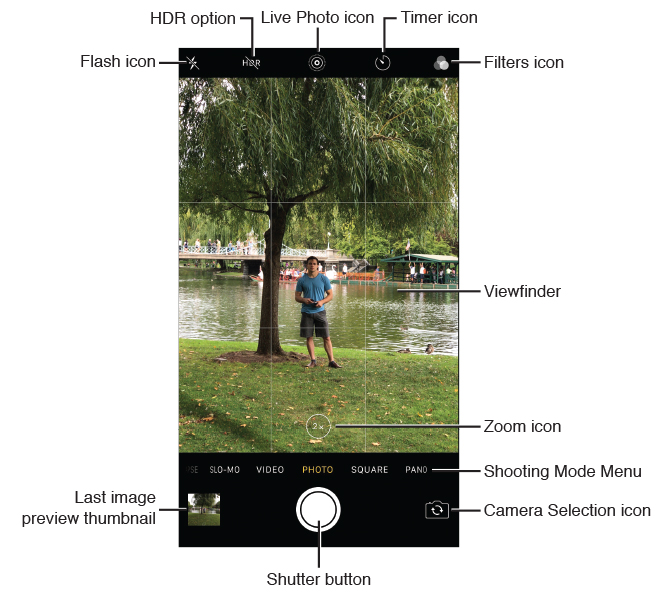
FIGURE 9.1
Tap the circular Zoom icon to switch between the wide-angle and telephoto lenses on an iPhone 7 Plus, iPhone 8 Plus, or iPhone X.
FIGURE 9.2
Press and hold your finger on the circular Zoom Intensity icon to make the redesigned zoom slider appear.
When using the iPhone 7 Plus, iPhone 8 Plus, or iPhone X, the default is for the Camera app to always use the wide-angle lens with 1x (zero) zoom magnification. Use the reverse-pinch finger gesture or the zoom slider to adjust the zoom between 1x and 10x without manually switching between the rear-facing cameras. The iPhone automatically switches from one camera to another when it’s necessary.
Figure 9.3 shows what the zoom slider looks like on an older iPhone model that does not contain two rear-facing cameras. On an iPad, the zoom slider is displayed along the left margin of the viewfinder screen.
![]() Caution
Caution
When you’re using higher levels of the optical or digital zoom (higher than 5x, for example) with the iPhone 7 Plus, iPhone 8 Plus, or iPhone X, be sure to hold the smartphone very still as you press the shutter button to snap a photo. Even the slightest movement can cause the image to appear blurry or pixelated, particularly in low-light situations (when you aren’t using the flash). The Camera app’s built-in image stabilization sometimes compensates for this (mainly in well-lit situations), but not always.
FIGURE 9.3
Use the pinch or reverse-pinch figure gesture on the screen to make the zoom slider appear on older iPhone or iPad models.
![]() Note
Note
The Camera Selection icon displayed in the bottom-right corner of the viewfinder screen is still used to switch between the front- and rear-facing cameras
The cameras built in to the iPhone 7 series and iPhone 8 series now include what Apple refers to as Optical Image Stabilization, improved body and face detection, as well as other features that work behind the scenes to help you automatically take clearer, more vibrant photos in a broader range of shooting situations.
![]() Note
Note
The iPhone X offers what Apple refers to as Dual Optical Image Stabilization, an even more advanced version of Optical Image Stabilization, which helps to compensate for unwanted camera movement or shaking while shooting.
The iPhone 7 series, iPhone 8 series, or iPhone X have four auto-adjusting LEDs to create the True Tone flash rather than just two. This enables the smartphone to better analyze the available light, and then use the flash to simulate but brighten the ambient light when taking a photo. This new Quad-LED True Tone flash should help reduce red-eye, overexposed subjects, and unwanted shadows that a typical camera flash often causes. In some cases, though, you can capture more authentic colors and lighting by turning on the HDR shooting mode instead of using the flash.
![]() Tip
Tip
When you’re using one of the latest iPhone models and viewing the Home screen, you can place and hold your finger gently on the Camera app icon to reveal a Touch 3D menu that enables you to access the Selfie picture taking feature, record a video, record a slo-mo video, or take a portrait by tapping one of the listed options (see Figure 9.4).
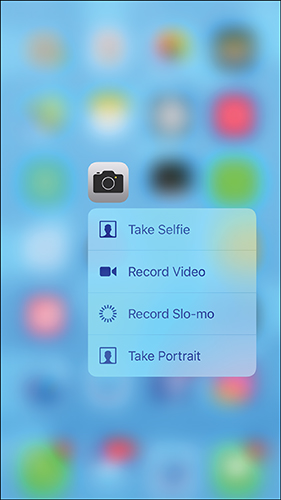
FIGURE 9.4
Quickly launch a specific feature of the Camera app directly from the Home screen by placing and holding your finger on the Camera app icon for about 2 seconds and using the iPhone’s 3D Touch functionality.
Taking Photos or Shooting Video
The Camera app that comes preinstalled with iOS 11 is likely to be the app you primarily use to take photos or shoot HD video. However, many third-party apps allow you to take pictures and replace the need to rely on the Camera app. This is especially the case with social media apps, like Facebook, Instagram, Twitter, and Snapchat.
![]() Caution
Caution
The same iOS 11 version of the Camera app is installed on all iOS mobile devices. The features and functions of the Camera app depend on which iPhone or iPad model you’re using, so some features might not be available to you.
![]() Note
Note
If you activate the iCloud Photo Library feature offered by the Photos app (which enables you to sync your digital images between all iOS mobile devices and computers linked to the same iCloud account), your main photo album where all your photos are stored, including all newly shot photos, is called All Photos. However, when iCloud Photo Library is turned off, the main album where photos you take are stored is called Camera Roll.
Launching the Camera App
There are several easy ways to launch the Camera app:
![]() From the Home screen, tap the Camera app icon.
From the Home screen, tap the Camera app icon.
![]() From the main Lock screen, swipe from right to left.
From the main Lock screen, swipe from right to left.
![]() Tap the Camera app icon in the Control Center.
Tap the Camera app icon in the Control Center.
![]() On an iPhone with 3D Touch capabilities, press the Camera app icon on the Home screen to reveal a pop-up menu for using specific Camera app features (refer to Figure 9.4).
On an iPhone with 3D Touch capabilities, press the Camera app icon on the Home screen to reveal a pop-up menu for using specific Camera app features (refer to Figure 9.4).
![]() Activate Siri and say, “Launch the camera app.”
Activate Siri and say, “Launch the camera app.”
![]() If the Camera app is already running in the background, access the App Switcher and select the Camera app.
If the Camera app is already running in the background, access the App Switcher and select the Camera app.
Shooting Photos or Video
All iPhones and iPads have at least two built-in cameras—one in the front and one on the back of the device, but the iPhone 7 Plus, iPhone 8 Plus, and iPhone X each have three built-in cameras. The front-facing camera makes it easier to snap photos of yourself (that is, take a “selfie,” or participate in video calls via FaceTime or Skype).
The rear-facing camera (which can take much higher-resolution photos or video) enables you to photograph or record whatever is in front of you. Tap the camera-shaped Camera Selection icon to switch between cameras.
![]() Note
Note
The iPhone 7 Plus, iPhone 8 Plus, and iPhone X all have two, 12MP rear-facing cameras. This means that every image uses 12 million individual pixels (colored dots) to compose and display the image. The cameras built into the iPhone X (and the functionality offered by them) is the most advanced to date, allowing you to take clearer, more vibrant photos in a wider ranger of lighting and shooting situations.
The main camera viewfinder screen, which occupies the main area of the screen, appears as soon as you launch the Camera app on an iPhone or iPad. What you see in this viewfinder is what will be captured in your digital photo (or video).
On the iPhone, along the top and bottom of the screen are several command icons and options. On an iPad, most command icons and options are displayed along the right margin of the screen.
![]() Note
Note
If you’re using an older iPhone or iPad model (pre-iPhone 6 series or pre-iPad Pro), some of the features and functions discussed in this chapter (such as HDR Auto mode, Live Photo, Burst shooting mode, and Portrait Lighting), aren’t available to you.
To view the last photo you shot (or the last video clip recorded), tap the Image Preview thumbnail displayed in the bottom-left corner of the viewfinder screen (iPhone), or just below the Shutter button on an iPad. You can then use the Photo app’s viewing and editing functions on that image or video clip.
At the bottom center of the screen on the iPhone is the camera’s Shutter button. On the iPad, it’s located in the right margin. Tap this to snap a photo or to start and stop the video recording.
![]() Caution
Caution
If you accidently press and hold the Shutter button for too long when trying to snap a single image, Burst shooting mode activates, and you wind up with several similar images taken in quick succession. To avoid this, be sure to quickly tap the Shutter button, not press and hold it down.
In Photo mode, if you press and hold the Shutter button, Burst shooting mode automatically activates on newer iPhone and iPad models. This feature enables you to shoot multiple photos in quick succession (several frames per second) without having to keep pressing the Shutter button.
This feature is ideal for capturing a fast-moving subject, for example, and enables you to capture an action or event that happens very quickly. You can always delete the unwanted (extra) photos after choosing your favorite image(s) from the sequence.
Images shot using Burst shooting mode are placed in a separate album in the Photos app called Bursts.
Understanding the Shooting Modes
From the Shooting Mode menu offered on the latest iPhone models, your options include Time-Lapse, Slow-Mo, Video, Photo, Square, and Pano. Use your finger to manually scroll left or right to select your shooting mode. The active shooting mode is highlighted in yellow directly above the Shutter button.
On an iPad, the available shooting modes are displayed below the Shutter button in the right margin of the viewfinder screen. Scroll up/down to view and access them.
![]() Note
Note
If you’re using one of the latest iPhones, the Selfie shooting mode enables you to snap a photo and use the smartphone’s entire screen as your flash. You can access this feature from the Home screen using the Camera app’s 3D Touch menu, or anytime you’re using the front-facing camera (as long as the flash option is set to On or Auto).
Here’s how you can use the six shooting modes:
![]() Time-Lapse—Enables you to set up the Camera app to automatically keep snapping one photo at a time (the time interval is dynamically set by the iOS device) until you manually turn off this function. This feature works best if you mount the iOS mobile device on a tripod or use it with a stand. It’s great for capturing changes that happen in a single scene over time, such as a sunrise or sunset. The content created when using the Time Lapse feature is stored in the Photos app as a video, not as a series of photos.
Time-Lapse—Enables you to set up the Camera app to automatically keep snapping one photo at a time (the time interval is dynamically set by the iOS device) until you manually turn off this function. This feature works best if you mount the iOS mobile device on a tripod or use it with a stand. It’s great for capturing changes that happen in a single scene over time, such as a sunrise or sunset. The content created when using the Time Lapse feature is stored in the Photos app as a video, not as a series of photos.
When shooting with Time Lapse mode, the longer you leave the feature turned on (so the Camera app keeps taking photos automatically over an extended period of time), the longer the interval is between shots. Typically, if you leave this feature turned on long enough, the images are condensed into a 30- to 40-second mini-movie that shows the animated time-lapsed images.
![]() Slo-Mo—Enables you to shoot high-action video but play it back in slow motion. When using one of the latest iPhone or iPad models, you can capture slow-motion video in 1080p resolution, at up to 240 frames per second. This shooting mode is ideal if you’re shooting a fast-moving subject or a high-action activity.
Slo-Mo—Enables you to shoot high-action video but play it back in slow motion. When using one of the latest iPhone or iPad models, you can capture slow-motion video in 1080p resolution, at up to 240 frames per second. This shooting mode is ideal if you’re shooting a fast-moving subject or a high-action activity.
![]() Video—Enables you to shoot HD-quality video using your iPhone or iPad. Depending on which device you’re using, you can shoot 4K resolution video at up to 60 frames per second. Keep in mind that your iPhone or iPad is ideal for shooting relatively short video clips. These HD video files take up a tremendous amount of storage space, so if you want to shoot long home videos, consider using a dedicated video camera.
Video—Enables you to shoot HD-quality video using your iPhone or iPad. Depending on which device you’re using, you can shoot 4K resolution video at up to 60 frames per second. Keep in mind that your iPhone or iPad is ideal for shooting relatively short video clips. These HD video files take up a tremendous amount of storage space, so if you want to shoot long home videos, consider using a dedicated video camera.
![]() Note
Note
In Settings, you can select the video shooting resolution. The options vary based on the device you’re using.
To adjust the default video resolution on any iPhone or iPad, launch Settings, tap the Camera option, and then tap the Record Video option or Record Slo-Mo option.
Keep in mind that the higher the resolution you select, the larger your video files will be. Larger files require more internal storage space in your mobile device.
![]() Photo—Used for taking most pictures, this shooting mode allows you to snap regular, rectangular-shaped digital images at the highest resolution the front- or rear-facing camera that’s built in to your iPhone or iPad is capable of.
Photo—Used for taking most pictures, this shooting mode allows you to snap regular, rectangular-shaped digital images at the highest resolution the front- or rear-facing camera that’s built in to your iPhone or iPad is capable of.
![]() Tip
Tip
The shooting resolution of the rear-facing camera can capture images and video at a much higher resolution than the front-facing camera. So, unless you’re taking a selfie (a photo of yourself and whatever is behind you), you’ll typically capture clearer, more vivid, and more detailed images and video using the rear-facing camera.
![]() Square—Automatically precrops images as you’re shooting photos to be compatible with services such as Instagram. You wind up with square images.
Square—Automatically precrops images as you’re shooting photos to be compatible with services such as Instagram. You wind up with square images.
![]() Pano—Launches the Camera app’s panoramic mode, which is ideal for shooting vast landscapes, skylines, or large groups of people. You wind up with a long, rectangular image (see Figure 9.5).
Pano—Launches the Camera app’s panoramic mode, which is ideal for shooting vast landscapes, skylines, or large groups of people. You wind up with a long, rectangular image (see Figure 9.5).

FIGURE 9.5
The Pano (panoramic) shooting mode is ideal for shooting images of vast landscapes, large groups of people, or very wide areas.
![]() Tip
Tip
In addition to the Time-Lapse option, the Camera app on more recent iPhone and iPad models offers a Timer option. To turn on the timer, tap the Timer icon, and then set it for 3 or 10 seconds. Doing this determines how long the Camera app waits between the time you press the Shutter button and when an image is actually taken and saved.
![]() Note
Note
The Live Photo feature of the Camera app enables you to snap a photo but capture it as a two- to three-second mini-movie (with sound) that can later be viewed as an animated image on any iPhone, iPad, iPod touch, Mac, Apple TV, or Apple Watch that’s using the Photos app or is capable of displaying digital photos in other ways. For example, you can use a Live Photo as your custom watch face on the Apple Watch, or as the Lock screen wallpaper on your iPhone or iPad.
A Live Photo can still be treated as a regular digital image file. The iOS 11 edition of the Photos app allows you to edit, share, email, and print Live Photos.
To capture a Live photo, from the viewfinder screen when taking a photo, tap the Live icon, which looks like a target and is in the top-center of the screen on an iPhone. On an iPad, it’s the top command icon in the right margin of the viewfinder screen. When the feature is active, this icon is yellow.
Discovering Portrait Mode
For iPhone 7 Plus, iPhone 8 Plus, and iPhone X users, the Portrait shooting mode is available from the Camera app. When you select Portrait mode, the rear-facing telephoto lens (5x zoom) of the iPhone is automatically selected, and a depth-of-field effect automatically is used, which means this shooting mode helps to ensure that your intended subject is in focus and displayed clearly, but the background is slightly blurred. This feature works best when you’re holding the camera at least several feet away from your intended subject, and there’s some type of background behind your subject.
![]() Tip
Tip
When your subject is located in front of anything that can be seen at a distance behind it, experiment using Portrait mode to tinker with the image’s depth of field and create visually interesting effects in your photos that draw more attention to your subject. If your subject is standing directly against a wall, this feature won’t work. The farther your subject is away from what’s in the background, the more dramatic the blurred depth of field effect will be.
When you’re using Portrait mode, be sure to tap the viewfinder screen directly over the intended subject to ensure that the Camera app’s autofocus sensors home in on your intended subject rather than on something else in the foreground, background, or to either side of your subject.
![]() Note
Note
When using Portrait mode, your intended subject can be a person, pet, or any object that’s clearly positioned in front of something else.
To use the Portrait shooting mode, select it from the shooting mode menu. (Remember, this option appears only if you’re using a compatible iPhone model.) Portrait mode is listed between the Photo and Square shooting modes. After you select it, tap your intended subject. The autofocus sensor appears over your subject.
In Figure 9.6, which uses Photo mode on an iPhone 7 Plus, notice that both the main subject in the foreground and the background are equally in focus. When you switch to Portrait mode, however, and tap your subject to use the auto-focus sensor directly on it (as shown in Figure 9.7), the subject stays in focus, but the background becomes slightly blurred. A Depth Effect message appears on the screen to indicate that this feature is being used.
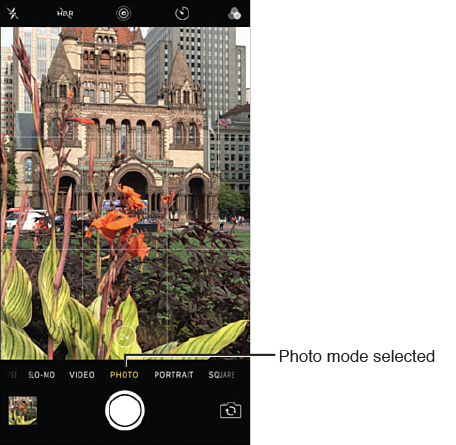
FIGURE 9.6
With Photo mode, your intended subject (in this case, a flower) and what’s in the background (the historic church) appear in focus.

FIGURE 9.7
With Portrait mode, the rear-facing telephoto lens of the compatible iPhone is used. Tap your intended subject, and the background automatically becomes blurred.
Figures 9.8 and 9.9 show the two photos side by side to highlight the differences in the results.
FIGURE 9.8
This shot was taken using the Photo shooting mode.
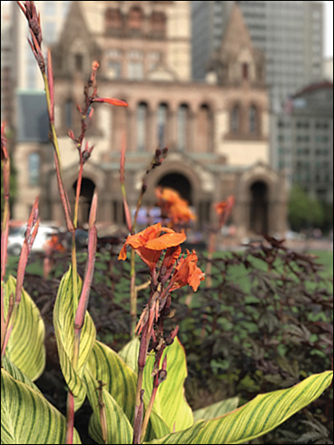
FIGURE 9.9
This shot was taken using Portrait mode.
![]() What’s New
What’s New
Exclusive to the iPhone 8 Plus and iPhone X (and released as part of a free update to the iOS 11 operating system) is a new feature called Portrait Lighting. When you use this feature with the Portrait shooting mode, the Camera app simulates the professional lighting apparatus that would be available in a photo studio. The feature enables you to digitally incorporate special lighting effects directly into your photos while you’re shooting or while editing in the Photos app.
After you turn on the Portrait shooting mode, tap the 3D-looking box icon in the viewfinder screen to scroll between lighting effects. Options include Stage Light Mono, Natural Light, Studio Light, Stage Light Mono, and Contour Light (see Figure 9.10). Each dramatically changes the appearance of a photo taken using the Portrait shooting mode.
FIGURE 9.10
Tap the Portrait Lighting Effect icon, and then scroll between the different effects. You’ll see within the viewfinder how each impacts the image’s appearance in real-time.
![]() What’s New
What’s New
If you’re an iPhone X user, another new feature is the ability to use the Portrait shooting mode with the front-facing camera. This allows you to take crystal-clear selfies but have the background appear blurry in order, which adds a more artistic flare and depth to your photos. You can add Portrait Lighting Effects to portrait images taken with the front-facing camera.
Using the HDR Shooting Feature
The HDR feature offered by the Camera app stands for High Dynamic Range. You can use it only with the rear-facing camera. When turned on, this feature captures the available light differently, which can help you compensate for a photo that would otherwise be over- or underexposed. You can use this feature anytime, but it works extremely well in low-light situations.
When you take a photo using HDR mode, the iPhone or iPad actually captures several separate images simultaneously, and then automatically blends them into a single image in a fraction of a second. By doing this, you can capture more depth and contrast, plus make better use of available lighting. The result is often a more detailed and vibrant photo.
You can decide whether the original photo and the HDR version of a photo are both saved in the All Photos/Camera Roll album, or if just the HDR version of the image should be saved. To make this adjustment, launch Settings, tap the Camera option, and then turn on or off the virtual switch associated with the Keep Normal Photo option.
On the latest iPhones and iPads there are three HDR-related options: On, Off, or Auto. (On older iPhone and most iPad models, only the On or Off options are available.) If HDR Auto is available, it enables you to consistently capture the most vibrant photos in a wide range of lighting situations. The HDR button is displayed at the top of the Camera app’s viewfinder screen on the iPhone, or above the Shutter button on the iPad. Tap it to toggle the HDR mode when taking photos.
![]() Note
Note
When you turn on the HDR mode, the flash automatically is turned off.
Using the Built-In Flash
On the iPhone (and iPad Pro models), the flash icon enables you to control whether the built-in flash is used as you’re shooting photos or video. Tap the Flash icon, and then tap the On, Off, or Auto option to toggle this feature.
The Auto option is offered only on the newer iPhone and iPad Pro models. The Auto option enables the smartphone to analyze the available light for you, and it automatically determines whether the flash is needed.
![]() Tip
Tip
Keep in mind that even in low-light situations, you can often achieve better results if you shoot photos using the HDR shooting mode rather than using the flash.
![]() Note
Note
Starting with the iPhone 5 series, the smartphone includes what Apple calls a True Tone flash. This is really two flashes that work together and emit light in different colors. As a result, the Camera app analyzes the available light in each shooting situation and enhances it, while monitoring the natural colors in a photo.
The True Tone flash automatically reduces the red-eye effect when taking pictures of people, and it can often reduce or eliminate unwanted shadows in photos. In the iPhone 7 series, iPhone 8 series, and iPhone X, the built-in flash uses four separate LEDs that work together, as opposed to just two.
A True Tone Flash is also built in to the latest iPad Pro models.
![]() Tip
Tip
If you’re using a newer iPhone model and you activate the flash when using the front-facing camera, the entire screen of your iPhone automatically serves as a simulated flash to brighten your face when the ambient light isn’t adequate. Make sure the Camera app’s flash option is turned on for this to work.
Using the Autofocus and Exposure Control Options
As you’re looking at the Camera app’s viewfinder and framing your shot, be sure to force the app to focus on your intended subject by tapping the screen directly over where your subject appears.
When you do this, the Autofocus Sensor box appears in the viewfinder, and the Camera app focuses on your intended subject (that is, what’s in the box). What’s behind, in front of, above, below, or to the sides of your subject may be slightly blurred.
If you’re shooting people, however, the Camera app automatically identifies each person’s face in a photo and focuses on those faces. An Autofocus Sensor box appears around each person’s face.
![]() Tip
Tip
In addition to the Autofocus Sensor, some devices also have a manual Exposure Control slider. It looks like a sun-shaped icon that appears to the immediate right of the Autofocus Sensor.
When this Exposure Control slider is displayed, place your finger on the icon and slide it up or down to manually adjust the exposure before snapping the photo.
Snapping a Photo
Snapping a single digital photo using the Camera app is simple. Follow these steps:
1. Launch the Camera app.
2. Make sure the shooting mode is set to Photo or Square.
3. Choose between the front- and rear-facing cameras by tapping the Camera Selection icon. (If you’re using an iPhone 7 Plus, iPhone 8 Plus, or iPhone X, after selecting the rear-facing camera, use the zoom feature, or tap the 1x or 2x icon to switch between the wide-angle and telephoto lenses).
4. Compose your image by holding up your device and pointing it at your intended subject(s).
5. If desired, set the Timer feature.
6. To add a special effect to the image as you’re shooting, tap the Filter icon and then select one of the nine displayed filters by tapping its preview image (see Figure 9.11). The Filters icon is displayed in the top-right corner of the Camera app’s viewfinder screen on the iPhone.
![]() What’s New
What’s New
The nine special effect filters built into the iOS 11 edition of the Camera app (and Photos app) are called Vivid, Vivid Warm, Vivid Cool, Dramatic, Dramatic Warm, Dramatic Cool, Mono, Silvertone, and Noir. Selecting the filter called Original is the same as choosing no filter at all.
![]() Note
Note
You don’t have to add a filter when you shoot the photo. You can always add a filter later when editing a photo using the Photos app.
7. Choose the intended subject of your photo, such as a person or an object. Tap your finger on the screen where your subject appears in the viewfinder. An Autofocus Sensor box appears on the screen at the location you tap. The box is where the camera focuses (as opposed to something in the foreground, background, or next to your intended subject).
8. If necessary, use the Exposure Control slider (the sun-shaped icon) to manually adjust the exposure just before snapping a photo. You can later adjust or correct a variety of problematic issues in a photo—including its exposure, contrast, saturation, color, and shadows—using the Photos app.
FIGURE 9.11
As you’re shooting a photo, choose one of the nine image filters to add an effect.
![]() Caution
Caution
As you’re holding your iPhone or iPad to snap a photo or shoot video, be sure your fingers don’t accidentally block the camera lens. On the more recent iPhone and iPad Pro models, located near the rear-facing camera lens is a tiny True Tone flash. Keep your fingers clear of this, as well.
9. If you want to use the Camera app’s zoom feature, use a pinch motion on the screen. A zoom slider appears directly above the Shooting Mode menu and the Shutter button. Use your finger to move the dot on the slider to the right to zoom in, or to the left to zoom out. Alternatively, use a pinch or reverse-pinch finger gesture to manage the zoom level while shooting.
![]() Tip
Tip
Remember, the iPhone 7 Plus, iPhone 8 Plus, and iPhone X displays the zoom intensity in a circular icon near the bottom center of the viewfinder screen. To make the zoom slider appear, place and hold your finger on the 1x icon. The redesigned zoom slider is displayed . Move your finger slightly left or right to increase or decrease the zoom intensity, or use the reverse-pinch or pinch finger gesture to adjust the zoom intensity.
10. Decide whether you want to use HDR mode or the built-in flash (iPhones or iPad Pro only) when taking the photo. (You can also choose neither of these options.)
11. When you have your image framed in the viewfinder, tap the Shutter button to snap the photo. Alternatively, press the Volume Up (+) or Volume Down (–) button on the side of your iPhone/iPad, which also serve as a Shutter button when using the Camera app.
12. The photo is saved in the All Photos/Camera Roll album of the Photos app. You can now shoot another photo or view the photo using the Photos app.
![]() Note
Note
All regular photos are automatically stored in the All Photos/Camera Roll album as they’re taken. The iOS 11 edition of the Photos app automatically places selfies into a separate Selfies album and sorts your panoramic shots into a Panoramas album.
Videos are placed in a separate Videos album, and slo-mo video clips are stored in an album called Slo-Mo.
When you use the Burst shooting mode, these groups of images are clustered together and placed in the Bursts album.
All these albums are automatically created for you. In the Photos app, you can move images into the Favorites album or any custom-named albums you create manually.
Shooting a Panoramic Photo
To take advantage of the panoramic shooting mode to snap a photo of a landscape, city skyline, or a large group of people, follow these steps:
1. Launch the Camera app.
2. Swipe the Shooting Modes menu, and select the Pano shooting mode.
3. Position your iPhone or iPad’s viewfinder to the extreme left of your wide-angle shot. (When using the Pano shooting mode, hold the smartphone or tablet upright in portrait mode, unless you’re shooting a very, very tall object.)
![]() Tip
Tip
If you tap the large arrow icon in the viewfinder, you can switch the panning direction from right to left, instead of left to right as you’re capturing a panoramic shot.
4. Tap the Shutter button, and then slowly and steadily move (pan) your iPhone or iPad from left to right (see Figure 9.12).

FIGURE 9.12
When taking panoramic shots, the viewfinder screen looks very different on your iPhone or iPad.
5. The panorama slider moves from left to right as you capture your image. Tap the Shutter button again when you’re finished, or continue moving the iOS device to the right until the entire length of the image has been captured.
![]() Tip
Tip
If you pan the iPhone or iPad too fast or too slow while taking a panoramic shot, or if your hand isn’t steady, you see a message that tells you what you’re doing wrong. Although you can continue taking that shot, for the best results, tap the Shutter button to stop shooting and then start again from step 1.
6. The panoramic photo is saved in the Panoramas album of the Photos app. You can then view, edit, or share it from within Photos. Like all images, it’s also accessible from the All Photos/Camera Roll album.
![]() Tip
Tip
When viewing a panoramic photo, hold your iPhone or iPad in landscape mode; however, when shooting a panoramic shot, hold it in portrait mode.
Shooting HD Video
From the Camera app, you can easily shoot stunning HD video. Follow these basic steps for shooting video using your iPhone or iPad:
1. Launch the Camera app.
2. Select the Video shooting mode from the Shooting Mode menu. (If you want to shoot slow-motion video, select the Slo-Mo option, if it’s offered by your iOS mobile device.)
![]() Note
Note
When you select the Video shooting mode, on the viewfinder screen the Flash icon, Timer, Shooting Mode menu, Shutter button, and Camera Selection icon are all displayed. On the iPhone, the selected video resolution is displayed in the top-right corner of the screen.
When you start actually filming video, some of these icons disappear, and on some iPhones and iPads, the Still Image Shutter button becomes accessible.
3. Tap the camera selection icon to choose which camera you want to use. You can switch between the front- and the rear-facing camera at any time.
![]() Note
Note
The newer iPhone and iPad models are capable of shooting 4K resolution video using the rear-facing camera.
On any iPhone or iPad, set the video recording resolution by launching Settings, tapping the Camera option, and then tapping the Record Video or Record Slo-Mo options. The available options are listed on the Record Video submenu screen, as well the amount of internal storage space needed to record each minute of video.
For example, when the iPhone 7 Plus records video in 4K resolution at 30 fps, each minute of saved video content requires 350MB of internal storage space.
4. If applicable, tap the Flash icon (iPhone/iPad Pro) to turn on the flash and use it as a continuous light source while filming video.
5. Hold your iPhone or iPad up to the subject you want to capture on video. Set up your shot by looking at what’s displayed in the viewfinder.
6. In the viewfinder, tap your intended subject to make the autofocus sensor appear. If necessary, and if your device supports this feature, you can also manually adjust the Exposure Control using the displayed slider.
7. When you’re ready to start shooting video, tap the Shutter button. The red dot turns into a red square. This indicates you’re now filming. Your iPhone or iPad captures whatever action you see on the screen, as well as any sound in the area.
8. As you’re filming video, a timer is displayed on the screen (see Figure 9.13). Your only limits to how much video you can shoot is based on the amount of available storage space in your iOS device and how long the battery lasts. (This app is designed for shooting short video clips rather than full-length home movies.)
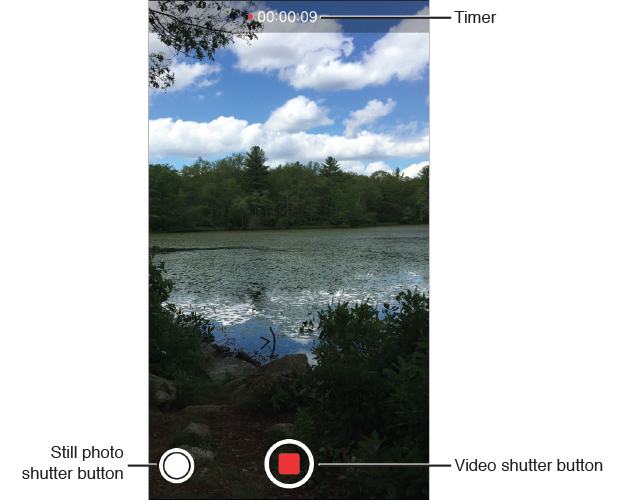
FIGURE 9.13
When shooting video on your iPhone or iPad, make sure the timer is counting up. This indicates you’re actually recording.
9. As you’re filming, tap anywhere on the screen to focus on your subject using the app’s built-in autofocus sensor.
10. To stop filming, tap the Shutter button again. Your video footage is saved. You can now view, edit, and share it from within the Photos app (or use an optional video-editing app, such as iMovie).
Although the Photos app enables you to trim your video clips as well as view and share the videos, if you want to edit your videos, plus add titles and special effects, use Apple’s feature-packed iMovie app, which is available from the App Store. For more information about iMovie, visit www.apple.com/apps/imovie.
![]() Tip
Tip
Depending on which iPhone or iPad model you’re using, your Camera app might include a second, circular (white) Shutter button (refer to Figure 9.13). You can use this second Shutter button to snap high-resolution digital images at the same time you’re shooting HD video.
Using the Photos App to View, Edit, Enhance, Print, and Share Photos and Videos
Use the Photos app to view, organize, edit, and share images stored on your iOS device or in your iCloud account. The iOS 11 version of the Photos app includes a robust selection of photo editing and image enhancement tools.
![]() Note
Note
The Photos app has built-in face and object recognition, and it automatically sorts your images based on who or what appears in them.
In addition, the Camera app uses the GPS (Location Services) capabilities of your mobile device to record the exact location where each photo (or video) is shot, and it also records the time and date. As a result, the Photos app’s Related feature is able to sort images based on location, who or what appears in your photos, and when they were taken and group those images together.
When you tap the Albums icon in Photos, you’ll discover that separate folders for People and Places have automatically been created. These folders are auto-populated with appropriate photos as you take them.
![]() Tip
Tip
Tap the Places option to view a world map that shows the places you’ve been where you’ve taken photos, as well as how many photos you took there (see Figure 9.14).
Place your finger on this map and drag it around to reposition it. Use the reverse-pinch or pinch finger gestures to zoom in or out.
Tap any location tag on the map to view the collection of photos taken there. For this feature to work, you must have the Location Services feature turned on for the Camera and Photos apps.
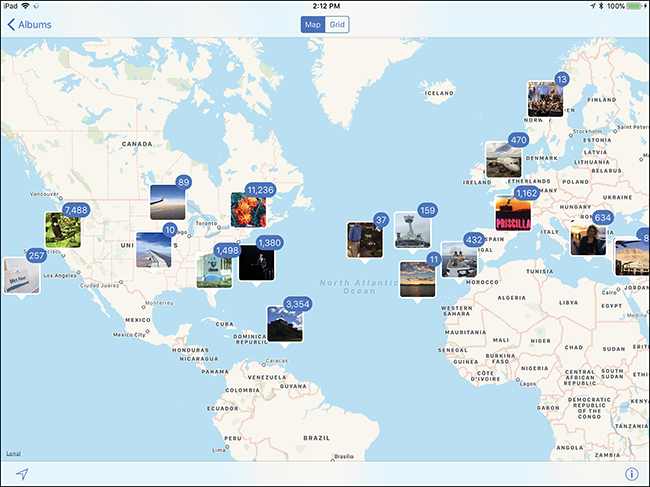
FIGURE 9.14
The Places option in the Photos app enables you to see where in the world you’ve taken photos, and then quickly find and view those images (shown on an iPad Pro).
![]() Note
Note
The All Photos/Camera Roll, Favorites, People, Places, Videos, Selfies, Live Photos, Portrait, Panoramas, Time-Lapse, Bursts, Screenshots, Slo-Mo, and Recently Deleted albums are automatically created on your behalf in Photos. These albums are populated with appropriate photos and video clips as you take them or transfer them into your iPhone or iPad.
If you opt to use third-party photography apps, additional albums may automatically be created to store images taken or edited using those apps. Any Albums you create are displayed with their custom names under the My Albums heading.
From within Photos, you now can search for photos with specific objects in them. To do this, access the Search tool built into the Photos app and type an object that appears within any of your photos, such as trees, cars, houses, or cats.
For example, type dog within the Search field to locate and view thumbnails for all photos you have taken that contain dogs. You can also activate Siri and say, “Show me photos that contain dogs.”
You can also to search images by the people who appear in them (assuming you’ve used the People feature within the Photos app to associate names with faces).
Experiencing Photos and Videos with Memories
The Memories feature automatically groups related images together and can present them in an animated, movie-like format that can include a title, music, special effects, and cinematic transitions. To access this feature, tap the Memories icon at the bottom of the Photos screen. The app uses your images and video clips to create a collection of animated presentations.
Thumbnails for the Memories that the Photos app has created are displayed (see Figure 9.15). Tap any Memory thumbnail to view, edit, and then share that Memory. From within the Photos app, you can share Memories just as you share a photo or video clip—on Facebook, for example.
When you tap one of the Memories thumbnails, the collection of images in it is displayed. Tap the Play icon to preview the Memory as is, or tap the Select option to choose specific images you want to delete from the Memory (see Figure 9.16).
FIGURE 9.15
The Photos app automatically creates Memories for you.
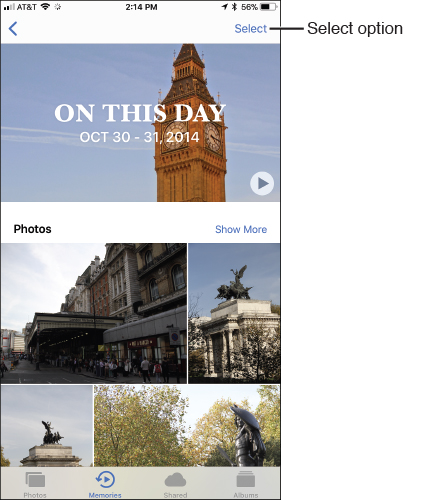
FIGURE 9.16
After selecting a Memory, you can view, edit, or share it from within the Photos app.
After tapping Select and choosing one or more images, tap the Share icon to share the selected images, or use the command icons displayed at the bottom of the Share menu to Copy, Hide, Print, or Duplicate these images.
As a Memory is playing, tap the screen to customize it. For example, choose a theme, like Happy, Uplifting, Epic, Dreamy, or Sentimental. Tap the Short or Medium option to determine the playback length of the Memory, or tap the Edit icon to fully customize the Memory.
From the Edit menu, you can add a custom title to the Memory, select music to be played in the background, customize the duration of the animated presentation, and add/remove photos and video clips included in the Memory.
![]() Tip
Tip
If you have video clips included in the memory, those need to be edited separately, as standalone videos (either using the Photos app or iMovie, for example). Those edited video clips can then be incorporated into an animated memory.
After making changes to the Edit menu, tap Done to save your changes to the Memory. Tap the Share icon to Share the Memory via email, text message, or by publishing it on Facebook or Twitter, for example.
![]() Tip
Tip
In addition to the usual sharing options offered when you access the Share menu while working with Memories, if you have the YouTube app installed on your iPhone or iPad and have an active YouTube (Google) account, you can upload your Memories directly to your YouTube channel from the Photos app.
![]() Tip
Tip
When viewing a particular Memory, scroll down to the bottom of the thumbnail images that are included in that Memory. Here, you’ll discover a Related heading, with additional Memories that are somehow related to the one you’re viewing. There’s also an Add to Favorite Memories option and a Delete Memory option.
Navigating Around the Photos App
Displayed at the bottom of the Photos app are a series of command icons. Use these to navigate your way around the app, find your images, and then use the tools offered by the app to manage your photo collection, edit your images, and ultimately share them.
The main command icons in the Photo app include the following:
![]() Photos—Tap this option to sort and view all images stored locally within your iPhone/iPad or that are stored in your iCloud Photo Library. Images are sorted based on the time and date, as well as the location where they were taken. Use your finger to scroll up or down this screen. To select and work with any of the images, tap the Select option, and then tap their image thumbnails. You can then delete those images, share them (by tapping the Share icon), copy them into another folder (using the Add To option). Tap any single image to view it, and then use the Photos app’s editing and management tools to work with that single image.
Photos—Tap this option to sort and view all images stored locally within your iPhone/iPad or that are stored in your iCloud Photo Library. Images are sorted based on the time and date, as well as the location where they were taken. Use your finger to scroll up or down this screen. To select and work with any of the images, tap the Select option, and then tap their image thumbnails. You can then delete those images, share them (by tapping the Share icon), copy them into another folder (using the Add To option). Tap any single image to view it, and then use the Photos app’s editing and management tools to work with that single image.
![]() Tip
Tip
When you select the Photos option, images are sorted based on when or where they were shot. Years displays thumbnails of all images shot in a particular year and includes details about where those images were shot.
Collections further breaks down a Years grouping to sort images based on when and where they were taken. Moments enables you to display thumbnails of images in a Collection that represent one location or date.
As you’re viewing thumbnails in the Moments view, tap one of them to view and work with a single image. Tap the < icon in the top-left corner of the screen to move backward between individual photos, Moments, Collections, and Years.
![]() Memories—Access, view, edit, manage, and share Memories that are automatically created by the Photos app.
Memories—Access, view, edit, manage, and share Memories that are automatically created by the Photos app.
![]() Shared—Access and manage images you’ve stored in custom folders, or that have been placed online using iCloud’s Photo Sharing feature.
Shared—Access and manage images you’ve stored in custom folders, or that have been placed online using iCloud’s Photo Sharing feature.
![]() Albums—Access, view, and manage albums (folders), as well as individual images stored in each album. In addition to the albums that the Photos app has created and populated for you, you can create and manage your own custom albums, and place groups of photos you select in them.
Albums—Access, view, and manage albums (folders), as well as individual images stored in each album. In addition to the albums that the Photos app has created and populated for you, you can create and manage your own custom albums, and place groups of photos you select in them.
Moving Images Between Albums
To copy selected images from one album to another as you’re viewing thumbnails for images in a specific album, tap the Select option. Then, one at a time, tap the images you want to copy into another album. A check mark appears on each image thumbnail you select.
Tap the Add To option, and then tap which album from the displayed listing you want to move the selected images to. For example, you can choose the Family album if you have iCloud Family Sharing activated.
To create a new album from scratch, from the Add to Album screen, tap the New Album option. When prompted, type a title for the new album, and then tap the Save button.
Create as many separate albums as you need in the Photos app to properly group and organize your images. As you create a new album, it syncs with iCloud Photo Library if you have this feature turned on.
![]() What’s New
What’s New
After you select one or more images and tap the Share icon, you see the Share menu. Included within this menu is the Save to Files option. Tap this icon to transfer the image(s) to any cloud-based file folder or subfolder on any online file-sharing/storage service that you have linked with the new Files app, such as iCloud, Dropbox, Google Drive, or Box. (An Internet connection is required.) The selected images remain stored within the Photos app, but a copy is uploaded to the selected service. See Chapter 7, “Using iCloud and the Files App,” for more information.
Viewing an Image in Full-Screen Mode
When viewing thumbnails of your images, tap any single image thumbnail to view a larger version of it.
On the iPhone, the Share, Favorites, Edit, Trash, and Back (<) icons and commands are displayed along the top and bottom of the screen. On the iPad (see Figure 9.17), these icons and commands are along the top of the screen.
Along the bottom center of the screen are thumbnails for all the images stored in the Album you’re currently accessing.
![]() Tip
Tip
By tapping the Favorites (heart-shaped) icon associated with each image, you can place that image into a separate Favorites album and then opt to view or share only those images.
As you’re viewing a photo, tap it to hide or show the command icons and options available, which automatically appear and then disappear after a few seconds when you first open a photo.
FIGURE 9.17
When viewing a single image (shown here on an iPad Pro), you can share it, add it to the Favorites folder, edit it, or delete it.
![]() Tip
Tip
When viewing an image, scroll down to view a map showing where the image was taken, and keep scrolling down to view related images. You can use the Show Photos from This Day option to view additional photos taken on the same day as the one you’re viewing.
To exit the single-image view and return to the multi-image thumbnail view, tap anywhere on the screen to make the command icons appear, then tap Back (<) in the upper-left corner of the screen.
Tap the Edit icon to reveal the Photo app’s image-editing options (shown in Figure 9.18 on an iPhone).
FIGURE 9.18
The Edit icons give you access to the Photo app’s image editing tools.
Tools for Editing Photos
When you tap the Edit icon while viewing a single image, several command icons are displayed on the screen (refer to Figure 9.17). These icons provide the tools for quickly editing and enhancing your image. Your options are explained in the next sections.
![]() Note
Note
You can use the tools built into iOS 11 to edit animated photos taken using the Live shooting mode. Live photos can be viewed using the Photos app running on any iPhone, iPod touch, or iPad that’s running iOS 10 or iOS 11, the Apple Watch (running WatchOS 3 or WatchOS 4), via Apple TV (or Apple TV 4K), or any Mac that’s running macOS Sierra or macOS High Sierra.
When editing Live photos on a newer model iPhone, you’re able to create image loops or use the new Bounce or Long Exposure options to make the Live images look even more impressive when they’re viewed or shared. The Bounce feature plays the Live photo (mini-movie) and then immediately plays it in reverse. Use the Long Explore option to capture the passing of time or movement within a single frame.
![]() Tip
Tip
The Markup feature enables you to use your finger (or the Apple Pencil on compatible iPad Pro devices) to annotate or draw directly on an image (see Figure 9.19).
To access this feature, open and view a single photo, and then tap the Edit icon. From the Edit screen, tap the More (…) icon and then tap the Markup icon (see Figure 9.20).
From the Markup screen, select your drawing or annotation tool and virtual ink color from the icons that are displayed at the bottom of the screen. You also can select a thickness for the virtual drawing tool.
Once the annotation and drawing tool is selected, draw or write on the image itself. Tap the Add (+) icon to add a text-based caption directly on the image, add a digital signature to the image, or use the Magnifier to view a close-up a portion of the image. Tap the Square, Circle, Text Balloon, or Arrow icon to add one of these graphic elements to the image (see Figure 9.21). Tap Done to save your changes.
Whatever you draw or annotate in an image is saved and becomes part of that image. Thus, it’s a good idea to create a duplicate image so you can keep the original and separately save the one you use the Markup features on.
Do this as you save the newly edited image the first time after using Markup. Alternatively, before using the Markup feature, open an image to view it, tap the Share icon, and then tap the Duplicate icon to create a copy.
FIGURE 9.19
Add text or draw on your photos using the Markup feature.
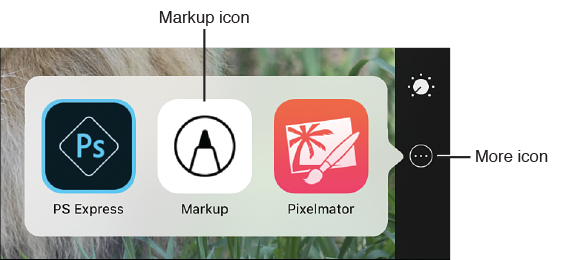
FIGURE 9.20
Tap the More icon and then tap the Markup icon.
FIGURE 9.21
Tap on the Add (+) icon to access this menu, which offers additional drawing and annotation tools, along with a Magnification tool.
Enhance
The Enhance icon looks like a magic wand. When you tap it, you can use a one-touch editing tool that automatically adjusts multiple aspects of a photo at once, including its contrast, exposure, and color, to make the image look better and the colors appear more vibrant. You can turn this feature on or off, but it is not manually adjustable.
Crop
Use the Crop tool shown in Figure 9.22 to manually adjust the cropping of the image by dragging one of the corners of the white frame horizontally, vertically, or diagonally. The Crop tool also enables you to straighten a photo and readjust its angle by placing your finger on the straightening dial and moving it. Tap the Image Rotation icon to rotate the image 90 degrees.
![]() Tip
Tip
After using any of the Cropping tools, be sure to tap Done to save your changes. Alternatively, tap Cancel to exit out of this option without saving your changes.
FIGURE 9.22
Tap the Crop icon to access tools for cropping, straightening, and rotating an image.
![]() Tip
Tip
As you’re cropping an image, tap the Aspect Ratio icon to select an aspect ratio, such as Original, Square, 3:2, 5:3, 4:3, 5:4, 7:5, or 16:9. Unless you need the image in a specific size, choose the Original option, and then use the Crop tool to adjust your image. Selecting an aspect ratio forces the basic dimensions to stay intact as you crop the image. This enables you to make accurately formatted prints later, without throwing off the image dimensions.
![]() Tip
Tip
Tap the Reset option to undo anything you’ve done using the Crop tool, Image Rotation tool, or Aspect Ratio tool.
Filters
The Photos app offers nine preinstalled special effect filters. After tapping the Filters icon, select the filter you want to apply to your image with a single onscreen tap. A preview of the altered image is displayed. To save the changes, tap Done. To discard the changes, tap Cancel, or tap another filter.
![]() Note
Note
In addition to the filters that come preinstalled with the Photos app, third-party developers can now create optional filters you can use with the Photos app.
Adjust
The Photos app enables you to edit or enhance many different aspects of a photo. Begin by tapping the Adjust icon. Then, from the Adjust submenu, tap the Light, Color, or B&W option. Each one of these options reveals a submenu that offers a variety of editing tools.
![]() Tip
Tip
As you’re using the various editing tools, press your finger gently on the image to toggle between viewing the original image and the edited version of the image you’re working with. Doing this enables you to see the effect the editing tool is having on your image.
The Light Tools
When you tap the Light tool, a slider appears that enables you to manually increase or decrease the overall Light effect in the image being viewed (see Figure 9.23).
When you tap the Menu icon (after tapping the Light option), a submenu with options for Brilliance, Exposure, Highlights, Shadows, Brightness, Contract, and Black Point is displayed (see Figure 9.24).
Tap any of these options to reveal a separate slider you can use to manually adjust that option. Keep in mind that you can mix and match the use of these tools to create truly customized visual effects.
FIGURE 9.23
Use the slider to manually adjust the master Light tool.
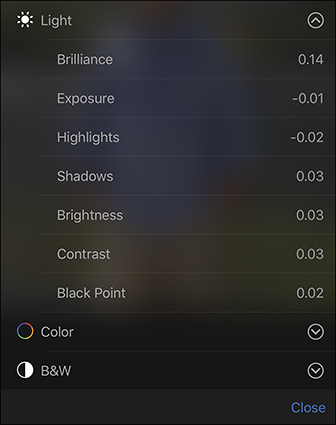
FIGURE 9.24
The Light menu gives you access to seven additional tools you can use one at a time to edit your image.
The new Portrait Lighting feature available on the iPhone 8 Plus and iPhone X can also be used to digitally alter and enhance the lighting of any image shot using Portrait mode. This can be done while taking the photo, or after the fact using the Photos app. This feature is separate from the Light tools available to all iPhone and iPad users working with the Photos app.
The Color Tools
When you tap the Color icon, a master Color slider is displayed. Use your finger to manually adjust this feature. Tap the Menu icon to reveal additional color-related options, including Saturation, Contrast, and Cast (see Figure 9.25).
Each of these tools (see Figure 9.26) has its own slider that you can manually adjust. Again, after making a change, be sure to tap Done to save your edits. Alternatively, tap Cancel/Close to exit out of the selected editing tool without making any changes.
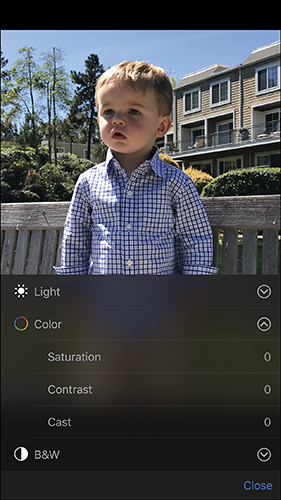
FIGURE 9.25
After tapping on the Color icon, tap the More menu icon to access tools for adjusting the Saturation, Contrast, and Cast in a photo.
FIGURE 9.26
Select the Saturation option and then use the slider to customize this setting.
The B&W Tools
Tap the B&W icon to instantly convert a full-color image into black and white. You can manually adjust the black, white, and grayscale colors using the B&W slider.
By tapping the Menu icon after selecting the B&W editing tool, additional submenu options enable you to manually adjust the image’s Intensity, Neutrals, Tone, and Grain, which all relate directly to the black-and-white effect. Upon tapping one of these options, a separate slider is offered, so you can adjust the intensity of the tool and the effect it has on your image.
After making a change, tap Done to save your edits or Cancel/Close to exit out of the selected editing tool without making any changes.
Editing Live Photos
A Live photo can be edited just as you would edit any other photo within the Photos app. Select the Live image, and then tap Edit to use any of the tools you read about in the previous sections.
However, new to iOS 11 are several Live Photo Effects. In addition to using any of the other image-editing tools, add the Loop, Bounce, or Long Exposure effect to an image to make Live images look even more impressive when they’re viewed or shared.
The Loop effect plays the Live photo in a continuous loop, as opposed to as a one- to two-second mini-movie. The Bounce feature plays the Live photo and then immediately plays it in reverse. Use the Long Explore option to capture the passing of time or movement within a single frame.
To edit a Live photo and add the Loop, Bounce, or Long Exposure effect, follow these steps:
1. Launch the Photos app.
2. Select the Live photo you want to edit and open it. All Live photos are automatically stored within the Live Photos album within Photos, as well as within the All Photos/Camera Roll album.
3. Tap Edit, and edit the photo as you normally would to enhance its appearance, straighten the image, or crop it.
4. After saving the edited Live photo, you see the edited photo (see Figure 9.27). Place your finger on the image and swipe up.
5. Displayed below the Effects heading are the options for Live, Loop, Bounce, and Long Exposure.
6. Tap the effect you want to preview (see Figure 9.28). For this example, I scrolled to the right on the iPhone and selected the Long Exposure effect.
7. If you like how the effect looks (shown in Figure 9.29), tap Back (<)to save the image and return to the previous Photos screen. If you opt to preview a different Live effect, swipe up on the image again and choose the effect you want from the menu.
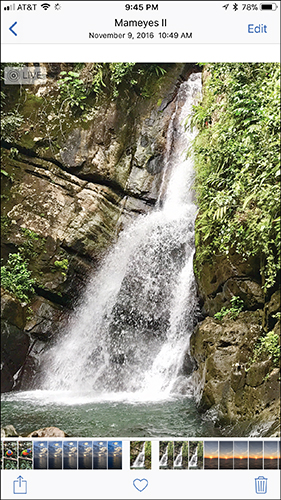
FIGURE 9.27
While looking at a Live photo within the Photos app, swipe up to access the Live Effects menu.
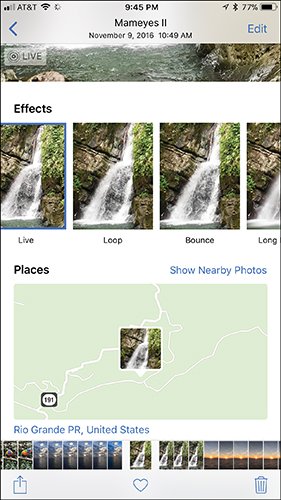
FIGURE 9.28
Choose the Live effect you want to preview by tapping an option displayed below the Effects heading.
FIGURE 9.29
See the effect you selected on the Live image. The Long Exposure effect for a Live photo is shown here.
Editing Videos
When you tap the thumbnail for a video clip, you have the option of playing that clip from within the Photos app. The Share, Favorite, and Trash icons are displayed on the screen.
Tap the Edit icon to access the video trimming (editing) feature. To trim a video clip, look at the filmstrip display of the clip and move the left or right editing tabs accordingly to define the portion of the clip you want to edit and keep.
The box around the filmstrip display (representing the portion of the video you want to keep) turns yellow, and the Done option appears (see Figure 9.30). Before tapping Done, tap the Play icon to preview your newly edited (trimmed) video clip.
After trimming the beginning or end of the video clip, tap Done to save your changes. The Save As New Clip option appears. Tap it. To gain access to a comprehensive and powerful set of video editing tools, download and install Apple’s iMovie app onto your mobile device.
FIGURE 9.30
Use the Photos app to trim video clips, but use the optional iMovie app to fully edit videos.
All videos you shoot and edit are stored automatically in the All Photos/Camera Roll album, as well as the separate Videos (or Slo-Mo album), which you can access by tapping the Albums icon at the bottom of the screen.
Printing Photos
iOS 11 is fully compatible with Apple’s AirPrint feature, so if you have a home photo printer set up to work wirelessly with your smartphone or tablet, you can create prints from your digital images using the Print command in the Photos app. Follow these steps to print an image:
1. Launch the Photos app.
2. Tap any image thumbnail to view that image. You might need to open an album first by tapping the album’s thumbnail if you have the Albums viewing option selected.
3. Tap the full-screen version of the image to make the various command icons appear.
4. Tap the Share icon.
6. When the Printer Options submenu appears, select your printer, determine how many copies of the print you’d like to create, choose the size of the desired print(s), and then tap the Print icon.
![]() More Info
More Info
To print wirelessly from your iOS device using the AirPrint feature, you must have a compatible printer. To learn more about AirPrint, and to configure your printer for wireless printing from your iPhone or iPad, visit https://support.apple.com/en-us/HT201311.
Third-Party Apps for Ordering Prints from Your Images
If you want to order professional-quality prints directly from your iPhone or iPad, and have them shipped to your door in a few days, use one of several apps (such as FreePrints) available from the App Store.
The free KickSend app, for example, determines your current location, and tells you which one-hour photo labs are in close proximity. Upload your photos to the desired lab directly from your iPhone or iPad, and within 30 to 60 minutes, pick up your prints at the selected location. KickSend is easy to use, and works with participating Walgreen’s, CVS Pharmacy, Target, and Walmart locations.
The free Shutterfly app also enables you to order prints directly from your iOS mobile device, plus it gives you the option to create custom photo gifts, such as coffee mugs, mouse pads, iPhone cases, T-shirts, and other products that showcase your images. You can order enlargements, canvas prints, and other types of wall art that showcase your favorite photos.
Sharing Photos and Videos
After you have selected one or more images, tap the Share icon to access the Share menu (shown in Figure 9.31).
FIGURE 9.31
The Share menu offered by the iOS 11 edition of the Photos app (shown here on an iPad Pro).
Sending Images Wirelessly via Airdrop
If you’re within close proximity to another Mac, iPhone, or iPad and the other computer or iOS mobile device also has the AirDrop feature turned on, you can wirelessly send images from within the Photos app using the AirDrop feature. This feature becomes active only when others nearby can receive an AirDrop transmission.
![]() Note
Note
Use the options available from the Share menu to share selected images via AirDrop, Text Message, Email, iCloud Photo Sharing, Twitter, Facebook, and Flickr. You can also copy images to a compatible cloud-based file-sharing/storage service by tapping the Save to Files icon.
App icons for third-party apps that are installed in your iPhone or iPad and that you can use for sharing images are also displayed here—for example, Instagram or Facebook Messenger.
From the Share menu, tap the Add to Notes icon to export a photo directly into a note in the Notes app, or tap Save PDF to iBooks to export the image using the PDF file format so it can be viewed in iBooks.
Tap the More (…) icon to display a list of all apps installed on your iPhone or iPad that are compatible with the Photos app’s Share menu. To add apps to the Share menu, turn on the virtual switch associated with each app listing when viewing the Activities menu.
The bottom row of command icons displayed in the Share menu offer a selection of tools for managing the selected image(s). Here, you’ll find options including Copy, Slideshow, Hide, Print, Duplicate, Assign to Contact, Use As Wallpaper, Add to Album, Save to Dropbox (if you have the Dropbox app installed and an active Dropbox account), Save to Files, and More (…) command icons. On an iPhone, you need to scroll horizontally to see all of the icons.
![]() Tip
Tip
In the Share menu are options for iCloud Photo Sharing. To place photos online in a particular iCloud Photos album that you will ultimately want to share with other people, tap the iCloud Photo Sharing option, and then fill in the prompts offered in the iCloud window that appears.
To upload the selected images to iCloud Drive (which is different from iCloud Photo Library or iCloud Shared Albums), select the Save to Files option, select iCloud Drive, and then choose the folder or subfolder where you want to store the photo(s).
Copying an Image to Another App
In the Photos app, you can temporarily store a photo in your iOS device’s virtual clipboard, and then paste that photo into another compatible app. To copy a photo into your device’s virtual clipboard, follow these steps:
1. In the Photos app, select a single photo and view it in full-screen mode.
2. Tap the image to make the command icons appear.
3. Tap the Share icon.
4. Tap the Copy icon. The photo is now stored in the virtual clipboard.
5. Launch a compatible app and then hold your finger down on the screen to use the Paste option and paste your photo from the clipboard into the active app.
Showing Images on a Television via Airplay
Instead of viewing an image in full-screen mode on your iPhone or iPad, tap the AirPlay icon and select Apple TV (or Apple TV 4K) to wirelessly transmit the image to your HD television set. To use this feature with an HD TV, you need the optional Apple TV (or Apple TV 4K) device. To use the feature with a Mac, be sure AirPlay on your Mac is turned on.
Deleting Photos Stored on Your iOS Device
To delete one image at a time as you’re viewing them in full-screen mode, simply tap the Trash icon.
To select and delete multiple images, as you’re looking at thumbnails, tap the Select button. Tap each thumbnail that represents an image you want to delete. A check mark icon appears in each image thumbnail to indicate that the image has been selected. Tap the Trash icon to delete the selected images.
![]() Caution
Caution
When you opt to delete a photo, it’s automatically deleted from the mobile device you’re using, as well as from iCloud Photo Library and all computers and mobile devices that are linked to the same iCloud account.
Taking Advantage of iCloud Photo Library
Turn on the iCloud Photo Library feature from within Settings on all your iOS mobile devices, as well as from the iCloud Control Panel on your Mac or PC computers, and you’ll be able to sync your entire digital photo library across all your computers and mobile devices, maintain an online backup of your images, and share groups of selected images (or entire albums) with other people.
To turn on iCloud Photo Library on each of your iOS mobile devices, launch Settings, tap your profile photo/username, tap the iCloud option, tap the Photos option, and then turn on the virtual switch associated with the iCloud Photo Library option. Use the other options in this submenu to customize the iCloud Photo Library feature on the device you’re using.
Keep in mind that, based on how many digital photos are in your entire digital photo library, you might need to upgrade your iCloud account (for a monthly fee) to get additional online storage space. Refer to Chapter 6, “Sync, Share, and Print Files Using AirDrop, AirPlay, AirPrint, and Handoff,” for more information about using iCloud.
When you store photos in your iCloud Drive, you can turn on the Family Sharing feature, which enables a Family Album. One single Family Album is accessible by up to six family members, who can freely add, edit, delete, and share images stored in that album. Everyone’s other image albums remain private and separate from the Family Album.
![]() More Info
More Info
Instead of using the Camera app to take pictures and the Photos app to edit, manage, print, and share your photos, browse through the hundreds of third-party photography- and videography-related apps available from the App Store that can be used with or instead of the Camera and Photos apps.
These optional apps can provide you with a much broader toolbox for taking and working with your digital images. To find these apps, visit the App Store and browse the Photo & Video category.
Following are 13 of the more popular and powerful photo- and/or video-editing apps available for the iPhone and iPad (in alphabetical order):
![]() Affinity Photo (iPad only)
Affinity Photo (iPad only)
![]() Afterlight
Afterlight
![]() Camera+
Camera+
![]() Enlight
Enlight
![]() Facetune 2
Facetune 2
![]() iMovie
iMovie
![]() Photoshop Express
Photoshop Express
![]() Photoshop Fix
Photoshop Fix
![]() Pixelmator
Pixelmator
![]() Pixomatic Photo Editor
Pixomatic Photo Editor
![]() PortraitPro Tablet (iPad only)
PortraitPro Tablet (iPad only)
![]() Snapseed
Snapseed
![]() Videoshop – Video Editor
Videoshop – Video Editor

